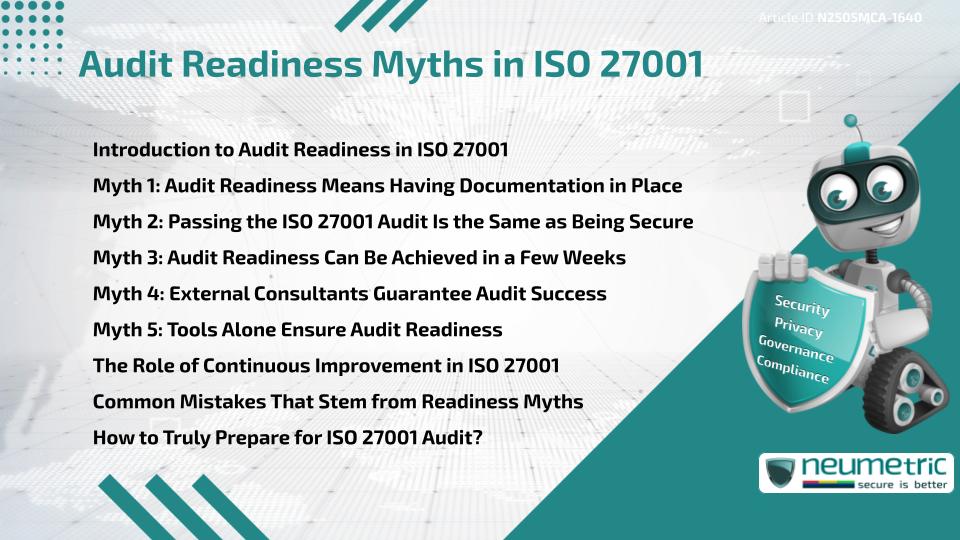Table of Contents
ToggleIntroduction to Audit Readiness in ISO 27001
ISO 27001, the International Standard for managing Information Security, is widely adopted by organisations aiming to build trust & demonstrate strong Data Protection practices. Achieving certification is a rigorous process. However, many businesses approach Audit readiness with misconceptions that can slow down or even derail their progress.
This article uncovers the most common Audit readiness myths in ISO 27001, offering practical insights to help teams separate fact from fiction. Whether you are just starting or mid-way through implementation, understanding these myths can streamline your path to Compliance & improve your long-term Security posture.
Myth 1: Audit Readiness Means Having Documentation in Place
A widespread misunderstanding is that Audit readiness simply means preparing documents & Policies. While documentation is important, it is only one part of the picture.
Auditors assess whether your Information Security Management System [ISMS] is not just documented but operational. That means real-world practices must align with written Policies. For example, having an Access Control policy is meaningless if Employees bypass it or it is not enforced through system controls.
Audit readiness is not paperwork readiness. It involves people, technology & consistent execution.
Myth 2: Passing the ISO 27001 Audit Is the Same as Being Secure
Another common belief is that passing the Audit proves the organisation is fully secure. This is one of the most persistent Audit readiness myths in ISO 27001.
ISO 27001 Compliance is about meeting defined requirements. Security, however, is a moving target. New Threats emerge daily. An Audit offers a snapshot of your controls at a specific point in time.
While ISO 27001 helps reduce Risk, it does not eliminate it. Believing otherwise can lead to complacency. True security requires ongoing vigilance beyond the Audit process.
Myth 3: Audit Readiness Can Be Achieved in a Few Weeks
Some teams rush to prepare for the Audit in just a few weeks. Unfortunately, this shortcut often leads to failure. Building a compliant ISMS requires time—usually several months—of planning, implementation & internal review.
Quick-fix strategies often involve copying templates without tailoring them to business needs. This can lead to superficial compliance that auditors quickly detect.
Effective Audit readiness takes time & effort. Rushing it may not only result in Non-Conformities but also a false sense of preparedness.
Myth 4: External Consultants Guarantee Audit Success
While consultants can offer valuable expertise, they cannot guarantee a successful Audit. This myth often stems from the idea that hiring a third party automatically shifts responsibility.
Consultants can guide you, offer templates & help identify gaps. But the responsibility of implementing & maintaining the ISMS lies with internal teams.
Auditors want to see that your Employees understand & operate the system. Overreliance on external parties can actually work against you during interviews & documentation reviews.
Myth 5: Tools Alone Ensure Audit Readiness
There is a growing belief that using ISO 27001 tools or platforms alone can guarantee readiness. Automation helps, but tools do not replace strategic thinking or effective Governance.
Security tools can help track Assets, automate controls & log activities. But without Risk Assessments, leadership involvement & a culture of security, tools offer limited value.
Technology should support—not substitute—the work required to meet Audit criteria.
The Role of Continuous Improvement in ISO 27001
Many Audit readiness myths in ISO 27001 overlook the importance of Continuous Improvement. Clause 10 of the Standard requires that organisations regularly review & enhance their ISMS.
Audit readiness is not a one-time project. It is a cycle of monitoring, reviewing & refining processes. Organisations that view readiness as an ongoing process are more likely to maintain certification & adapt to new Risks.
Embedding Continuous Improvement into your business culture sets the foundation for sustainable Compliance.
Common Mistakes That Stem from Readiness Myths
Misunderstanding Audit readiness can lead to:
- Incomplete Risk Assessments
- Untrained staff
- Outdated or unused Policies
- No records of internal audits or management reviews
These issues frequently arise when organisations chase certification without understanding the purpose behind each requirement. Awareness of Audit readiness myths in ISO 27001 can help prevent these common pitfalls.
How to Truly Prepare for ISO 27001 Audit?
Genuine Audit readiness means:
- Conducting regular internal audits
- Assigning clear roles & responsibilities
- Training Employees in Security awareness
- Performing detailed Risk Assessments
- Documenting continual improvement activities
Being ready for an ISO 27001 Audit means proving—not just claiming—that your Security practices are embedded into daily operations.
Takeaways
- Audit readiness goes beyond having documents—it requires operational alignment.
- Certification is not the same as complete security.
- Myths can lead to rushed, ineffective implementations.
- Continuous Improvement is central to ISO 27001 success.
- Tools & consultants are support mechanisms, not solutions in themselves.
FAQ
What is the biggest myth about Audit readiness in ISO 27001?
That having documents & Policies in place automatically means an organisation is ready for the Audit.
Can a company achieve Audit readiness in one month?
No. Most organisations need several months to properly implement & operationalise their ISMS.
Does passing the ISO 27001 Audit mean we are fully secure?
Not necessarily. It means your organisation met the standard’s requirements at the time of the Audit—not that you are immune to Threats.
Do tools like GRC platforms make Audit readiness automatic?
No. While helpful, tools alone cannot replace the need for leadership, planning & process execution.
Is hiring a consultant necessary to be Audit ready?
Consultants can help, but internal ownership & understanding are critical to true Audit readiness.
Do all Employees need to be involved in Audit readiness?
Yes. ISO 27001 requires organisation-wide awareness & involvement to maintain Compliance.
Is it enough to just follow a template for Audit readiness?
Templates help with structure but must be customised to your organisation’s actual Risks & operations.
Are internal audits optional before the main certification Audit?
No. Internal audits are a mandatory part of the ISO 27001 process & vital for identifying gaps.
Can organisations achieve ISO 27001 without long-term change?
No. Sustainable Compliance requires long-term cultural & operational shifts, not just short-term fixes.
Need help?
Neumetric provides organisations the necessary help to achieve their Cybersecurity, Compliance, Governance, Privacy, Certifications & Pentesting goals.
Organisations & Businesses, specifically those which provide SaaS & AI Solutions, usually need a Cybersecurity Partner for meeting & maintaining the ongoing Security & Privacy needs & requirements of their Clients & Customers.
SOC 2, ISO 27001, ISO 42001, NIST, HIPAA, HECVAT, EU GDPR are some of the Frameworks that are served by Fusion – a centralised, automated, AI-enabled SaaS Solution created & managed by Neumetric.
Reach out to us!


